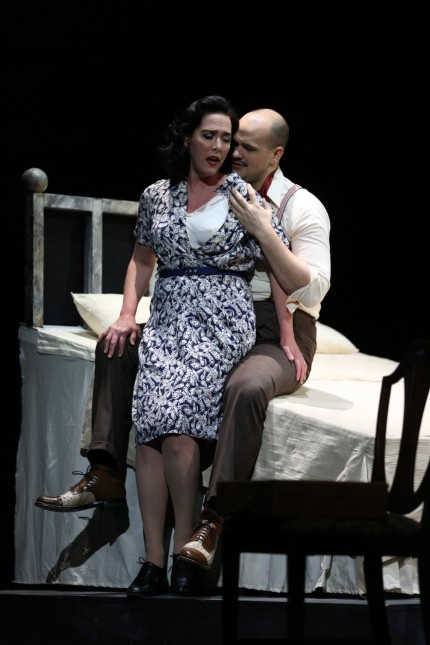COT delivers effective staging of Picker’s compelling “Thérèse Raquin”

Performances of American opera are not exactly thick on the ground in downtown Chicago–unless it happens to be the surefire box office bait of Porgy and Bess. So, kudos to Andreas Mitisek, general director of Chicago Opera Theater, for filling that continuing void and keeping the flickering flame alight for homegrown repertory.
For the first production of its 2015 season, COT is presenting the Chicago premiere of Tobias Picker’s Thérèse Raquin, which opened Friday night at the Harris Theater. And while not every aspect of the singing or production proved ideal, this was one of COT’s more successful shows of the Mitisek era, giving an effective staging of an opera that deserves to be better known by one of our finest composers.
Thérèse Raquin is Picker’s third opera—premiered in Dallas in 2001–and coming after Emmeline and The Fantastic Mr. Fox and before An American Tragedy.
The composer and librettist Gene Scheer have deftly adapted Emile Zola’s once-scandalous novel of the same name. The morally vacuous Thérèse is married to the rich, crippled mama’s boy Camille, yet she discovers a powerful sexual attraction to Camille’s best friend, the brutish painter Laurent. Embarking on a torrid affair, Laurent and Therese plot to kill Camille, yet after the act, the lovers are haunted by their guilt and both are ultimately destroyed by their crime.
Thérèse has its uneven elements. There is little flavor of the Paris milieu in the music, and the bits of contrasting light humor for the bourgeois supporting characters are less effective than the roiling dramatic peaks. Still, Picker is one of our most skillful opera composers, and his score is compelling and consistently engaging—restless, edgy and with a Prokofiev-like astringency, building to nerve-wracked climaxes for the murder of Camille and the subsequent guilty clashes of Laurent and Thérèse.
Mitisek has said that he casts for dramatic acuity more than voices and that was surely the case with Mary Ann Stewart in the title role. She brought an apt sensual quality and dark attractiveness to the anti-heroine, making manifest Thérèse’s unslaked libidinal impulses, yet vocally proved uneven at best. Her slender soprano sounded shallow and two sizes too small for the role early on, and in Thérèse’s lyrical arias Stewart displayed a painfully wide wobble. The soprano brought greater urgency and, it seemed, vocal strength after intermission, ratcheting up the dramatic impact of the confrontation scenes with Laurent.
With his shaved head and towering physical stature, Edward Parks was the uber-alpha male to the hilt, making manifest Thérèse’s attraction to him over Matthew Di Battista’s vertically challenged Camille. Brutish and dangerous, Parks commanded the stage like a Gallic Stanley Kowalski, singing with a big, forceful baritone and bringing searing intensity to his battles with Thérèse.
Matthew Di Battista was ideal casting as the lame, gullible Camille. The tenor brought an affecting, nice-guy persona to the role and showed a dauntingly powerful voice that belied his short stature. He threw out resounding top notes and tackled the stratospheric tessitura of Camille’s ghost with striking ease and agility.
COT perennial Suzan Hanson was, for once, cast in an age-appropriate role as Madame Raquin, Camille’s mother. Her big, raw-edged soprano was apt and Hanson brought impressive dramatic credibility to the woman in her later, stricken immobile state.
The cast was rounded out with admirable turns by Ani Maldjian as Suzanne, John Matthew Myers as Grivet and Zeffin Quinn Hollis as Olivier.
Mitisek conducted Picker’s reduced chamber version for 18 players solidly though in rather metrical fashion with insufficient dynamic contrast. He brought worthy intensity to the dramatic peaks yet too often failed to broaden the tempo and give space to the lyrical episodes.
Apart from a consistently sharp flute, the arrangement was capably played and an acceptable compromise. Still, textures sounded undeniably scrawny at times and one missed the sonic heft, varied colors and timbral ingenuity of Picker’s original score for full orchestra with large percussion battery.
The effective staging was in the cost-minded COT tradition with spare, minimalist sets by Alan E. Muraoka and artful lighting by David Jacques. Ken Cazan’s stage direction was fluid and efficient with a couple jarring lapses. Having the ghost of the drowned Camille made up like a Hammer Films monster and emerge from the bed to lick Thérèse’s face and push the lovers’ mouths together induced audience titters opening night. Likewise, having the ghost clamber on top of his mother and paw her was a bizarre distraction and only served to undermine the point of the scene, that Camille is informing his mother in a dream of the identities of his murderers.
Theatrical restraint is not a hallmark of the current COT era. Sometimes less really is more.
Thérèse Raquin will be repeated 3 p.m. Sunday and 7:30 p.m. February 25 and 28. chicagooperatheater.org; 312-704-8414.
Posted in Performances




